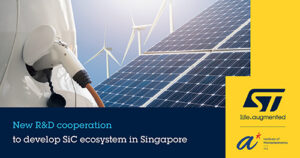Collaboration to help develop SiC ecosystem in Singapore

Nov 29, 2021: The Institute of Microelectronics (IME) at the Agency for Science, Technology and Research (A*STAR) and STMicroelectronics (NYSE: STM), a global semiconductor leader serving customers across the spectrum of electronics applications, announced the start of a Research & Development (R&D) collaboration in the field of silicon carbide (SiC) for power-electronics applications in the automotive and industrial markets. The collaboration sets a foundation for a comprehensive SiC ecosystem in Singapore and creates opportunities for other companies to engage with IME and ST in SiC research.
SiC solutions can outperform conventional silicon (Si) devices in power electronics for Electric Vehicles (EVs) and industrial applications to meet the need for power modules with smaller form factors or higher power outputs, as well as higher temperature operation. Under this research collaboration, A*STAR’s IME and STMicroelectronics aim to develop and optimize SiC integrated devices and package modules to offer significantly better performance in next-generation power electronics.
“We are pleased to collaborate with STMicroelectronics to develop breakthrough technologies that meet the needs of the growing electric vehicles market. Such efforts will continue to anchor high-value R&D activities in Singapore and bolster its reputation as an attractive regional hub for research, innovation and enterprise,” said Prof Dim-Lee Kwong, Executive Director of IME.
“This new collaboration with IME encourages the growth of a silicon carbide ecosystem in Singapore, as we ramp up our manufacturing activities there in addition to Catania (Italy). The multi-year collaborative effort helps us scale up our global R&D effort across our existing programs managed out of Catania and Norrköping (Sweden), covering the entire SiC value chain,” said Edoardo Merli, Power Transistor Macro-Division General Manager and Group Vice President of STMicroelectronics Automotive and Discrete Group. “IME’s strong knowledge and expertise in wide bandgap materials, and notably SiC, supports us in accelerating the development of new technologies and products addressing the challenges of sustainable mobility and better energy efficiency in a wide spectrum of applications.”
Note to editors
Power electronics involves the control and conversion of electricity using electronic devices. While silicon-based devices are predominantly used in today’s power electronics, next-generation power electronics are expected to be based on Wide-Bandgap materials like silicon carbide (SiC) owing to its better characteristics for power conversion. With higher energy efficiencies and smaller form factors, SiC power devices can yield energy savings in several key systems inside EVs such as the traction inverter (the “engine” of an EV), on-board chargers and DC-DC converters (which power headlights, interior lights, wiper and window motors, fans, pumps, and many other systems from the main high-power source, after conversion to a lower voltage).
For more information:
https://www.a-star.edu.sg/ime/Research/power-electronics
https://www.st.com/content/st_com/en/about/innovation—technology/SiC.html






